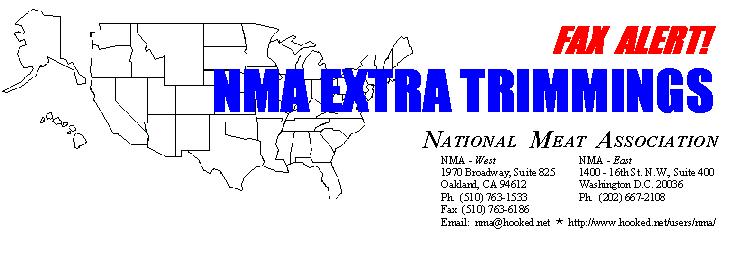

August 4, 1999
To: General Members
From: Ken Mastracchio, Director of Regulatory Issues
FSIS Listeria monocytogenes Notice: analysis by Olsson, Frank & Weeda
On August 3, 1999, the Food Safety and Inspection Service (FSIS) issued Notice 23-99 to aid the in-plant inspector on verifying an establishment�s compliance with the agency�s recent requirement that establishments manufacturing ready to eat (RTE) products reassess their HACCP programs to determine whether a critical control point would be required to control Listeria monocytogenes (L.m ).
According to the Notice, an ISP task will be scheduled under PBIS instructing the inspector to verify whether the establishment has performed a L.m reassessment under the following HACCP categories: not heat treated-shelf stable; heat treated-shelf stable; fully cooked-not shelf stable; and product with secondary inhibitors-not shelf stable. The Notice does not require establishments develop written documentation of the reassessment. However, the inspector will verify that the HACCP-trained individual has conducted the reassessment. If an establishment�s HACCP plan already has "validated" controls to specifically address L.m lethality and possible post processing contamination, no reassessment would be required.
If the establishment fails to perform the reassessment -- The inspector will not take any immediate regulatory action, other than reminding the establishment of the requirement to reassess, unless:
In such cases, the inspector is to issue an noncompliance report (NR) using the HACCP verification trend indicator. The inspector is then to inform the circuit supervisor of the establishment�s corrective and further planned actions provided in response to the NR.
The Notice does not specify what constitutes a "history of positive L.m product samples," but it does indicate that only FSIS� and the establishment�s own samples will be considered. Moreover, on the issue of product contact L.m findings, agency officials have clarified that more than an single L.m positive is contemplated by the criterion.
If the establishment conducts a reassessment, but does not modify the plan � The inspector will follow the same procedures as if the establishment did not perform the reassessment. In other words, the inspector will not take action unless either: (a) the product is exposed post processing and there is a history of L.m positives, or (b) there have been L.m findings on product contact surfaces without subsequent product actions. In these instances, an NR would issue and the Circuit Supervisor would be apprised of the establishment�s response.
If the establishment conducted a reassessment and modified the plan � The inspector will verify the modification through normal HACCP inspection activities. Importantly, the Notice indicates that testing programs are not mandatory.
Note on RTE product � There has been some confusion on whether certain products will be deemed RTE, such as a product containing a RTE meat product and a raw component which may contain L.m, e.g., a dinner with RTE poultry and blanched vegetables. The Notice includes a chart identifying the factors in determining whether such combination product is RTE or not RTE.
At a minimum, a not-RTE combination product must bear appropriate handling statements, such as keep frozen or keep refrigerated. In addition:
If, on the basis of the above, the establishment concludes the product is not RTE, such product would not need any additional critical control point; nor presumably would the finished product be subject to agency L.m testing.
The Notice will be distributed to the field shortly and the ISP task scheduled. Accordingly, establishments would be well-advised to complete their reassessment, if they have not already done so.